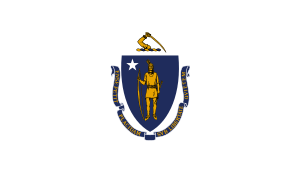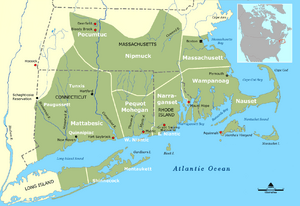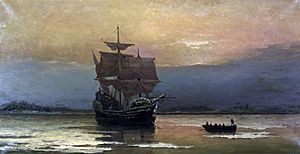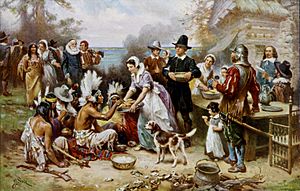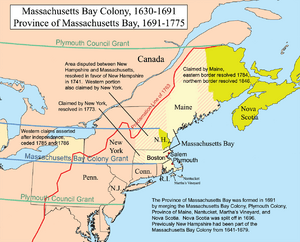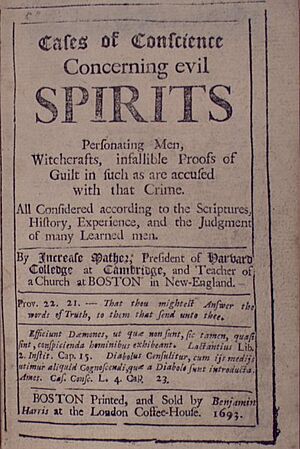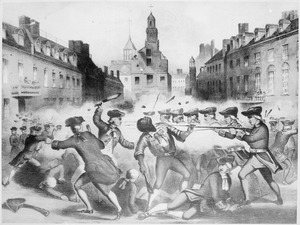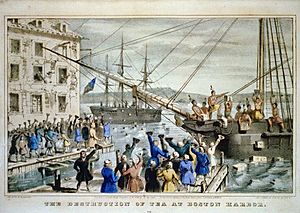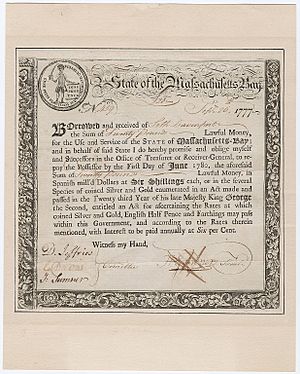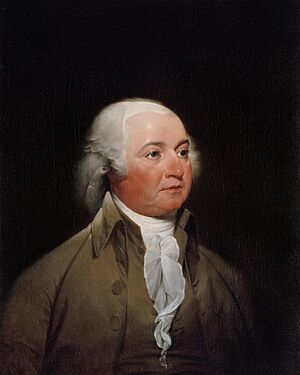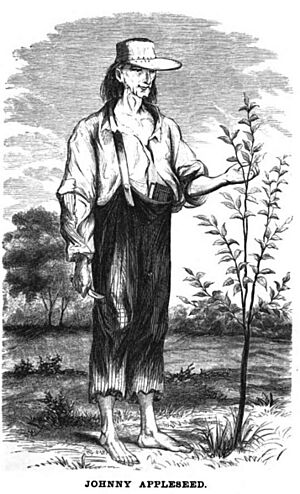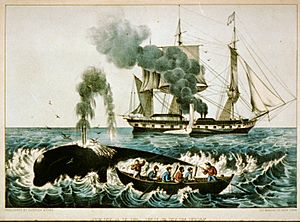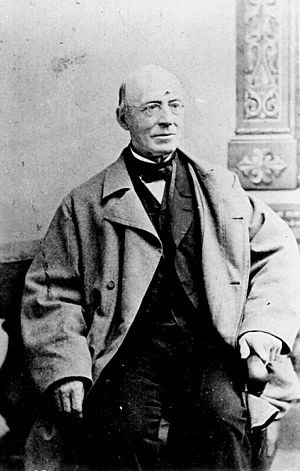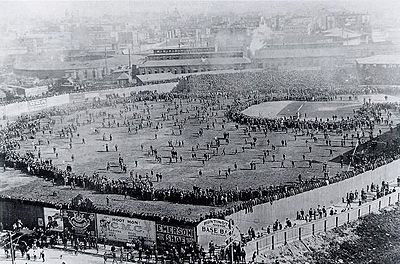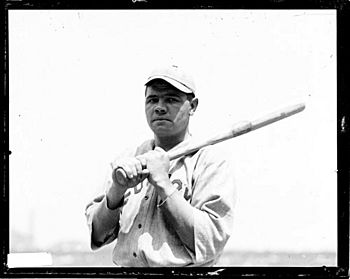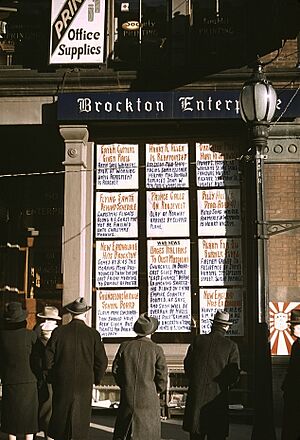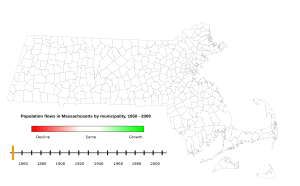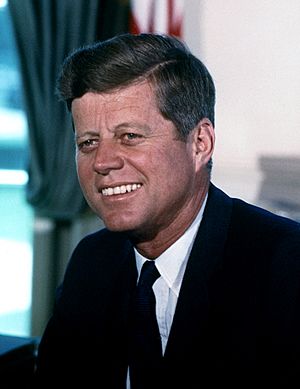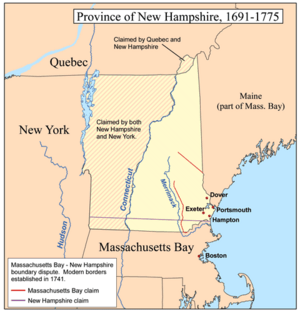History of Massachusetts facts for kids
Massachusetts was first settled by English people in the early 1600s. It became the Commonwealth of Massachusetts in the 1700s. Before the English arrived, many Algonquian-speaking Native American tribes lived there.
The first lasting English settlement in New England was Plymouth Colony. It was started in 1620 by the Pilgrims who sailed on the Mayflower. This colony set important examples but did not grow very large. A big wave of Puritan settlers arrived in 1630. They started the Massachusetts Bay Colony, which led to other New England colonies being founded.
In the 1670s, there was a tough war with Native Americans called King Philip's War. Many people died. The Puritans had a strict religion. They made people who disagreed with them leave the colony. The colony often argued with England about religious freedom and its rules. Most people were farmers. Business people created trade routes, sending ships to the West Indies and Europe. Sometimes, they traded goods against England's rules. These problems led to Massachusetts losing its special charter in 1684.
In 1686, the king created the Dominion of New England. This was to control all of New England and make the king's power stronger. Sir Edmund Andros ruled, but he was very unpopular. His rule ended suddenly in 1689 with an uprising in Boston. This happened because of the Glorious Revolution in England. The new king, William III, created the Province of Massachusetts Bay in 1691. This new area was similar to today's Massachusetts and Maine. The king appointed the governors, unlike before when colonists elected their own. This caused arguments between the colonists and the king. These arguments grew bigger in the 1760s and 1770s over who could collect taxes. The American Revolutionary War started in Massachusetts in 1775. This happened when London tried to stop local self-government.
Massachusetts officially adopted its state constitution in 1780. John Hancock was elected its first governor. The state was the first to end slavery in 1783. In the 1800s, Massachusetts became America's main manufacturing center. Factories in Springfield made precise tools and weapons. Large textile mills were built in Worcester, Haverhill, Lowell, and other towns. They used river power. Massachusetts was also a major center for new ideas and for the movement to end slavery. The Springfield Armory made most of the weapons for the Union during the American Civil War.
After the war, many immigrants from Europe came to the state. They helped its industries grow until the 1950s. Then, textile and other industries started to decline. This left many empty mills and factories. Labor unions became important after the 1860s. Big city political groups also grew strong. The state's strength in education helped develop an economy based on information technology and biotechnology in the late 1900s. This led to the "Massachusetts Miracle" in the late 1980s.
Contents
- Before European Settlement
- Europeans: Pilgrims and Puritans: 1620–1629
- Massachusetts Bay Colony Period: 1628–1686
- Dominion of New England: 1686–1692
- Royal Province of Massachusetts Bay: 1692–1774
- Revolutionary Massachusetts: 1760s–1780s
- Federalist Era: 1780–1815
- Early Industrial Period: 1815–1860
- Civil War and Gilded Age: 1860–1900
- Prosperity Decades: 1900–1929
- Depression and War: 1929–1945
- Economic Changes: Decline of Manufacturing 1945–1985
- The Kennedy Family
- Modern Economy and Society: 1985–Present
- Boundaries
- Images for kids
Before European Settlement
Before Europeans arrived, Massachusetts was home to several Algonquian-speaking tribes. These included the Wampanoag, Narragansett, Nipmuc, Pocomtuc, Mahican, and Massachusett. The Massachusett people lived in the Massachusetts Bay area. The Pennacook tribe lived near today's Vermont and New Hampshire borders and the Merrimack River valley.
Cape Cod, Nantucket, Martha's Vineyard, and southeast Massachusetts were home to the Wampanoag. These were the people the Pilgrims met. The Nauset tribe, closely related to the Wampanoag, lived at the very end of Cape Cod. The Nipmuc peoples lived in the central part and the Connecticut River valley. The Berkshires were home to the Pocomtuc and Mahican tribes. Some Narragansett and Mohegan people from Rhode Island and Connecticut also lived in the area.
These tribes grew crops like squash and corn. However, they mostly got their food by hunting, gathering, and fishing. Their villages had lodges called wigwams and longhouses. Leaders were male or female elders known as sachems.
Europeans began exploring the North American coast in the 1500s. But few tried to build permanent settlements. Early explorers included Englishman Bartholomew Gosnold (who named Cape Cod in 1602). Frenchman Samuel de Champlain mapped the northern coast in 1605 and 1606. Englishmen John Smith and Henry Hudson also explored. Fishing ships from Europe worked in the rich waters off the coast. They might have traded with some Native Americans.
Sailors and fishermen brought European diseases. These diseases caused a fast decline in the Native American population. This happened before many settlers arrived in the 1630s. Many Native Americans died from diseases like smallpox, measles, and influenza. They had no natural protection against these sicknesses. From 1617 to 1619, smallpox killed 90% of the Native Americans in the region.
Europeans: Pilgrims and Puritans: 1620–1629
The first English settlers in Massachusetts were the Pilgrims. They started their settlement at Plymouth in 1620. They became friends with the local Wampanoag people. This was the second successful English colony in North America, after Jamestown.
Before coming to America, the Pilgrims moved to Holland. They wanted to escape harsh treatment from King James for not following England's official church. In Holland, they had some religious freedom. But they were worried about the Dutch's open way of life. They asked the Virginia Company if they could settle in America as their own group.
In the fall of 1620, they sailed to North America on the Mayflower. They first landed near the tip of Cape Cod. The Mayflower was blown north off course and landed at a place called Plymouth. Since this land was not part of their original plan, they wrote the Mayflower Compact. This was one of America's first documents about self-governance.
Their first year was very hard. They did not have enough supplies. They also suffered badly from smallpox and malaria. However, the Wampanoag under-chief Massasoit helped them during this difficult time.
In 1621, they celebrated their first Thanksgiving Day together. They thanked God for a good harvest and for surviving. This Thanksgiving became a symbol of peace between Native Americans and the Pilgrims. Only about half of the Mayflower group survived the first year. But the colony slowly grew over the next ten years. By 1630, it had about 300 people.
Other small English settlements were attempted nearby. The Wessagusset Colony settled near today's Weymouth in 1622. This colony failed in 1623. Another small colony led by Robert Gorges also failed. Some settlers went back to England, some joined Plymouth, and others started small outposts around Massachusetts Bay. In 1624, the Dorchester Company started a settlement on Cape Ann. This colony lasted only until 1626, but a few settlers stayed behind.
Massachusetts Bay Colony Period: 1628–1686
After the Pilgrims, Puritans arrived. They founded the Massachusetts Bay Colony at today's Salem (1629) and Boston (1630). The Puritans believed the Church of England had too much hierarchy. They came to Massachusetts for religious freedom. Like Plymouth, their colony was founded under a royal charter. Most Puritans came from eastern and southwestern England.
Between 1628 and 1642, about 20,000 Puritans moved to Massachusetts. The Massachusetts Bay Colony quickly became larger and richer than Plymouth. This was because it had better harbors for trade and a growing merchant class.
New colonies were founded soon after Plymouth and Massachusetts Bay. This happened because of religious disagreements and a desire for more land. People like Anne Hutchinson and Roger Williams were sent away from Massachusetts Bay. Hutchinson held meetings where she discussed problems with Puritan beliefs. Williams thought Puritan beliefs were wrong and that Native Americans should be treated with respect. In 1636, Williams founded the colony of Rhode Island. Hutchinson joined him there two years later. Others, like John Wheelwright, moved north to Maine and New Hampshire. They did not like the religious rules in Massachusetts Bay.
In 1633, English settlers first saw the Connecticut River. They called it "The Great River" because it was much bigger than rivers in England. The Connecticut River is about twice as long as England's Thames River.
In 1636, William Pynchon led a group of settlers to found Springfield, Massachusetts. Pynchon, who was the Massachusetts Bay Colony's assistant treasurer, looked for the best place for trade and farming. He was surprised to find it unsettled. Springfield, originally called "Agawam," is just north of the Connecticut River's first waterfalls. These falls made it impossible for large ships to go further upstream. The area also had fertile farmland and was halfway between the ports of Boston and Albany.
Unlike the three settlements south of Springfield at the time (Windsor, Hartford, and Wethersfield, Connecticut), the Native Americans around Springfield were friendly. In 1640, Pynchon decided to join Springfield with the Massachusetts Bay Colony instead of the Connecticut Colony. He believed Connecticut's harsh rules toward Native Americans were bad for business and safety. So, in 1640, Springfield joined Massachusetts Bay. This set the southern and western borders of the Massachusetts Bay Colony.
In 1636, all the New England colonies fought the Pequot War against the Pequot tribe in southeastern Connecticut. The Pequots were almost wiped out. In 1646, the English Parliament gave missionary John Eliot money to preach to the Wampanoags. He successfully converted many of them. The colonial government placed these converted Native Americans, called Praying Indians, in villages around Boston. This was a defense strategy. The oldest such village, Natick, was built in 1651.
The Puritans came to Massachusetts to build a society based on their religious rules. They did not allow religious views that were very different from their own. Quakers, Baptists, and other religious Nonconformists were banned. In 1660, four Quakers were hanged on Boston Common. Besides Anne Hutchinson and Roger Williams, Thomas Hooker also left Massachusetts because of the Puritans' strictness. He founded the Connecticut Colony.
King Philip's War
Tensions between colonists and Native Americans led to King Philip's War (1675–76). This was the bloodiest Indian war of the early colonial period. Major battles happened in the Pioneer Valley and Plymouth. Starting in the 1670s, Massachusetts began to use slave codes. These rules removed limits on how long non-white people could be enslaved. It became common for wealthy families to own one or more household slaves.
King Philip's War was a huge disaster for 17th-century Puritan New England. In just over a year, nearly half of the region's towns were attacked. Major settlements like Providence, Rhode Island and Springfield, Massachusetts were burned down. New England's economy was almost destroyed, and many people were killed. Proportionately, it was one of the deadliest and most costly wars in North American history.
Economy
Because there was not enough hard money (coins), the Massachusetts Bay government started its own mint. It began producing colonial paper money, the Massachusetts pound, in 1652.
In 1645, the General Court ordered rural towns to raise more sheep. Sheep provided meat and, more importantly, wool for the local cloth industry. This reduced the need to import British cloth. The plan worked well. Many towns increased grazing lands, protected their sheep, and saw their flocks grow larger.
After Charles II became king again in 1660, he paid more attention to how the colonies were run. Parliament passed the Navigation Acts to control trade for England's benefit. Massachusetts had a busy merchant fleet and often broke these trade rules. Its government was slow to enforce them. This, along with strict religious practices and not allowing the Church of England to operate, led King Charles II to cancel Massachusetts's charter in 1684.
Dominion of New England: 1686–1692
In 1660, King Charles II returned to the throne. He decided to combine all the New England colonies into one big area. In 1685, James II, a Catholic, became king and put this plan into action. In June 1684, the Massachusetts Bay Colony's charter was canceled. But its government continued to rule until James appointed Joseph Dudley as the new President of New England in 1686.
Dudley's power also covered New Hampshire and parts of Rhode Island. He held this position until Sir Edmund Andros arrived to become the Royal Governor of the Dominion of New England. Andros's rule was very unpopular. He ruled without a representative assembly, took away land titles, limited town meetings, enforced the Navigation Acts, and promoted the Church of England. This angered almost everyone in Massachusetts. Andros especially upset colonists by questioning their land ownership. Most New Englanders owned land, which they saw as key to their freedom and wealth. They were horrified by this challenge to their land titles.
After James II was overthrown by King William and Queen Mary in late 1688, Boston colonists overthrew Andros and his officials in 1689. Both Massachusetts and Plymouth went back to their old governments until 1692. During King William's War (1689–1697), the colony tried to attack Quebec in 1690 under Sir William Phips. This attack failed. The colony was on the front lines of the war and faced many French and Native American raids on its northern and western borders.
Royal Province of Massachusetts Bay: 1692–1774
In 1691, William and Mary created the Province of Massachusetts Bay. This new province combined Massachusetts Bay, Plymouth, Maine, Nova Scotia (which included New Brunswick), and the islands south of Cape Cod. They chose Sir William Phips as its first governor. Phips arrived in Boston in 1692. He immediately faced the witchcraft panic in Salem. He set up the court that heard the famous Salem witch trials. He also managed the war effort until he was called back to England in 1694.
Economy
The province was the largest and most important economically in New England. Many American traditions and institutions were formed here. Unlike southern colonies, it was built around small towns, not scattered farms. The western part of Massachusetts, the Berkshires, was settled after the French and Indian War. Many Scots settled there. Sir Francis Bernard, the Royal Governor, named this area "Berkshire" after his home county in England. The largest settlement in Berkshire County was Pittsfield, Massachusetts, founded in 1761.
The education system, led by Harvard College, was the best in the 13 colonies. Newspapers became a major way to share information in the 1700s. Boston was a leader in this for the British colonies. Teenager Benjamin Franklin (born in 1706 in Milk Street) worked on one of the first newspapers, The New-England Courant. He ran away to Philadelphia in 1723. Five Boston newspapers shared many different opinions during the time leading up to the American Revolution. In Worcester, printer Isaiah Thomas made the Massachusetts Spy an important voice for western settlers.
Farming was the biggest economic activity. Most farming towns were self-sufficient. Families traded with each other for things they did not make themselves. Any extra goods were sold to cities. Fishing was important in coastal towns like Marblehead. Large amounts of cod fish were sent to slave colonies in the West Indies. Merchant trade was based in Salem and Boston. Many rich merchants traded worldwide. They often sent their sons and nephews to work as agents in ports across the empire. Their businesses grew a lot after 1783 when they were no longer limited to the British Empire. Shipbuilding was a fast-growing industry. Most other manufactured goods were imported from Britain or smuggled from the Netherlands.
Banking
In 1690, the Massachusetts Bay Colony was the first to print paper money in what would become the United States. Soon, other colonies also started printing their own money. Colonies needed currency because coins were scarce. Paper money was used to pay for government costs and to lend money to citizens. It quickly became the main way to trade within each colony. It was even used for trade with other colonies. However, some of this paper money could not be exchanged for gold or silver. This caused its value to drop.
The Currency Act of 1751 limited how much paper money New England states could print. It also set rules for exchanging paper money for gold or silver. This Act was passed because Rhode Island printed too much money, which made its value drop greatly. The Currency Act of 1764 completely banned printing paper money in the colonies. It also made it illegal to use paper money to pay debts. This was because its low value allowed people to pay debts with less valuable paper. This hurt trade and business for the king's subjects. The ban was very harmful to the colonies' economy and stopped trade both inside and outside the colonies.
The colony always had a shortage of gold and silver. It printed a lot of paper money, which caused prices to rise. This helped farmers but angered business people. By 1750, however, the colony stopped using paper money. It switched to using gold and silver coins. This happened because Britain paid Massachusetts back (in gold and silver) for its spending in the French and Indian wars. Large merchants and royal officials liked this change. But many farmers and smaller business people did not.
Wars with France
The colony fought alongside British soldiers in a series of French and Indian Wars. These wars involved brutal raids and attacks by Native Americans. The French organized and supplied these attacks from New France. Especially in King William's War (1689–97) and Queen Anne's War (1702–13), the colony's rural towns were directly attacked. Deerfield was raided in 1704, and Haverhill was raided in 1708. Boston responded by sending naval expeditions against Acadia and Quebec in both wars.
During Queen Anne's War, Massachusetts men helped in the Conquest of Acadia (1710). This area became the Province of Nova Scotia. The province was also involved in Dummer's War. In this war, Native American tribes were driven from northern New England. In 1745, during King George's War, Massachusetts forces successfully attacked Fortress Louisbourg. The fortress was given back to France at the end of the war. This angered many colonists who saw it as a threat.
During the French and Indian War, Governor William Shirley helped in the Expulsion of the Acadians from Nova Scotia. He tried to settle them in New England. After the expulsion, Shirley also helped transport New England Planters to settle Nova Scotia on the former Acadian farms. Many troops from Massachusetts took part in the successful Siege of Havana in 1762. Britain's victory in the war meant it gained New France. This removed the direct threat the French had posed to Massachusetts from the north.
Disasters
Boston was hit by a major smallpox epidemic in 1721. Some leaders suggested using a new method called inoculation. This meant giving a patient a weak form of the disease to make them immune. Puritan minister Cotton Mather and physician Zabdiel Boylston supported inoculation. Physician William Douglass and newspaper editor James Franklin were against it.
In 1755, on November 18, a very strong earthquake hit New England. It was the most destructive earthquake known there. Houses shook and cracked. Furniture fell over. Dr. Edward A. Holyoke of Salem wrote that he thought he would be buried in the ruins of his house. The shaking lasted for two to three minutes. It seemed to move from northwest to southeast. The ocean along the coast was affected. Ships shook so much that sleeping sailors woke up, thinking they had hit something.
In Boston, the earthquake threw dishes on the floor, stopped clocks, and bent weather vanes on churches. Stone walls fell down. New springs appeared, and old ones dried up. Underground streams changed course, emptying many wells. The worst damage was to chimneys. In Boston alone, about a hundred chimneys fell. About fifteen hundred were damaged, and streets were covered with bricks. Falling chimneys broke some roofs. Many wooden buildings in Boston fell, and some brick buildings were damaged. Despite the danger, no one was killed or seriously hurt. Aftershocks continued for four days.
Politics
The relationship between the provincial government and the king's appointed governor was often difficult. Governors tried to use the royal powers given in the charter. But the provincial government tried to limit the governor's power. For example, each governor was told to pass laws to give permanent salaries to royal officials. But the legislature refused. They used their power to give yearly payments as a way to control the governor. The province's habit of printing paper money also caused constant arguments. This was because it caused prices to rise. Important royal governors during this time included Joseph Dudley, Thomas Hutchinson, Jonathan Belcher, Francis Bernard, and General Thomas Gage. Gage was the last British governor of Massachusetts. His real power only covered Boston.
Revolutionary Massachusetts: 1760s–1780s
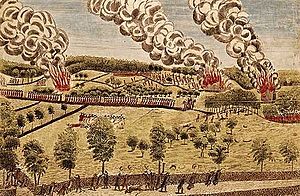
Massachusetts was a key place for the movement to become independent from Great Britain. It earned the nickname "Cradle of Liberty." Colonists here had long had problems with the British king. They even openly rebelled under the Dominion of New England in the 1680s. The Boston Tea Party shows the spirit of protest in the early 1770s. The Boston Massacre made the conflict worse. Actions against the British by men like Sam Adams and John Hancock, followed by British punishments, were a main reason for the Thirteen Colonies to unite. This also led to the start of the American Revolution.
The Battles of Lexington and Concord started the American Revolutionary War. They were fought in the Massachusetts towns of Lexington and Concord. Future President George Washington took command of what became the Continental Army after the battle. His first victory was the Siege of Boston in the winter of 1775–76. After this, the British had to leave the city. This event is still celebrated in Suffolk County as Evacuation Day. In 1777, George Washington and Henry Knox founded the Arsenal at Springfield. This led to many new ideas in Massachusetts' Connecticut River Valley.
Boston Massacre
Boston was the center of revolutionary activity in the ten years before 1775. Massachusetts natives Samuel Adams, John Adams, and John Hancock were important leaders in the revolution. Boston had been under military control since 1768. When customs officials were attacked by angry crowds, two groups of British soldiers arrived. They were housed in the city, which made the public increasingly angry.
In Boston on March 5, 1770, an incident started with people throwing rocks at a few British soldiers. It ended with British soldiers shooting five men. This became known as the Boston Massacre. The event caused more anger against British rule in the commonwealth. People were upset about taxes and the presence of British soldiers.
Boston Tea Party
One of the many taxes the colonists protested was a tax on tea. This tax was put in place by the Townshend Acts. It stayed even when most of those acts were canceled. With the Tea Act in 1773, tea sold by the British East India Company would be cheaper than smuggled tea. This meant less profit for Massachusetts merchants who traded tea. This led to protests against the company's tea arriving in Boston.
On December 16, 1773, a tea ship was planning to unload taxed tea in Boston. A group of local men called the Sons of Liberty secretly boarded the ship the night before. They dumped all the tea into the harbor. This act is known as the Boston Tea Party.
American Revolution
The Boston Tea Party made the British government pass the Intolerable Acts in 1774. These acts severely punished Massachusetts. They closed the port of Boston, which was the commonwealth's economic lifeline. They also reduced self-government. Local self-government ended, and the colony was put under military rule. The Patriots formed the Massachusetts Provincial Congress after the provincial legislature was shut down by Governor Gage. The suffering in Boston and the harsh rule caused great sympathy and anger throughout the Thirteen Colonies.
On February 9, 1775, the British Parliament declared Massachusetts to be in rebellion. They sent more troops to restore order. The local people largely opposed British authority. So, troops moved from Boston on April 18, 1775. Their goal was to destroy military supplies of local resisters in Concord. Paul Revere made his famous ride to warn the locals about this march.
On April 19, in the Battles of Lexington and Concord, the famous "shot heard 'round the world" was fired. British troops, after defeating the Lexington militia, were forced back into the city by local resisters. The city was quickly surrounded. Fighting broke out again in June when the British took the Charlestown Peninsula in the Battle of Bunker Hill. This happened after the colonial militia fortified Breed's Hill. The British won the battle, but at a very high cost. They could not break the siege.
The British tried to use biological weapons against the Americans. They sent civilians infected with smallpox behind American lines. But Continental General George Washington quickly stopped this. He started a vaccination program to keep his troops and civilians healthy. Soon after the Battle of Bunker Hill, General George Washington took charge of the rebel army. In March 1776, when he got heavy cannons, the British were forced to leave. This was the first big colonial victory of the war. Since then, "Evacuation Day" has been celebrated as a state holiday.
Massachusetts was not invaded again. But in 1779, the terrible Penobscot Expedition happened in the District of Maine. Maine was then part of Massachusetts. Trapped by the British fleet, American sailors sank the ships of the Massachusetts state navy to prevent them from being captured. In May 1778, the part of Freetown that later became Fall River was raided by the British. In September 1778, Martha's Vineyard and New Bedford were also subjected to a British raid.
John Adams was a leader in the independence movement. He helped get a unanimous vote for independence. On July 4, 1776, the United States Declaration of Independence was adopted in Philadelphia. It was first signed by Massachusetts resident John Hancock, who was president of the Continental Congress. Soon after, the Declaration of Independence was read to the people of Boston from the balcony of the State House. Massachusetts was no longer a colony; it was a state and part of a new nation, the United States of America.
Federalist Era: 1780–1815
A special meeting called a Constitutional Convention created a state constitution. John Adams wrote most of it. The people approved it on June 15, 1780. Adams, along with Samuel Adams and James Bowdoin, wrote in the Preamble to the Constitution of the Commonwealth:
We, therefore, the people of Massachusetts, acknowledging, with grateful hearts, the goodness of the Great Legislator of the Universe, in affording us, in the course of His Providence, an opportunity, deliberately and peaceably, without fraud, violence or surprise, on entering into an Original, explicit, and Solemn Compact with each other; and of forming a new Constitution of Civil Government, for Ourselves and Posterity, and devoutly imploring His direction in so interesting a design, Do agree upon, ordain and establish, the following Declaration of Rights, and Frame of Government, as the Constitution of the Commonwealth of Massachusetts.
John Adams from Boston was a very important person in the fight for independence and in forming the new United States. He was deeply involved in pushing for separation from Britain. He also helped write the Massachusetts Constitution in 1780. This constitution, through cases like Elizabeth Freeman and Quock Walker, effectively made Massachusetts the first state to have a constitution that declared universal rights and ended slavery. Adams became a minister to Britain in the 1780s. He was Vice President in 1789 and became President after Washington in 1797. His son, John Quincy Adams, later became the sixth U.S. President.
The New Constitution
Massachusetts was the first state to end slavery. The new constitution also removed any religious tests for holding political office. However, local tax money still had to be paid to support local churches. People who belonged to non-Congregational churches paid their taxes to their own church. Those without a church paid to the Congregationalists. Baptist leader Isaac Backus strongly fought these rules. He argued that people should be free to choose how they support religion.
Adams wrote most of the document. Even with many changes, it still follows his ideas. He did not trust perfect societies or pure democracy. He believed in a system where power was divided and checked. He admired the principles of the unwritten British Constitution. He insisted on having two parts to the legislature. This would represent both wealthy gentlemen and common citizens. Most importantly, he insisted on a government ruled by laws, not by people. The constitution also changed the name of the Massachusetts Bay State to the Commonwealth of Massachusetts. This constitution is still used today. It is the oldest constitution in use in the world.
Shays' Rebellion
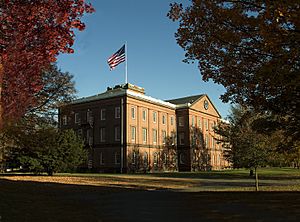
After the war, the economy in rural Massachusetts suffered. Merchants, needing money from overseas, demanded payments from local debtors. The state also raised taxes to pay off its war debts. Efforts to collect these debts from farmers who had little cash led to protests in August 1786. Rebels called themselves Regulators. They managed to shut down courts that were hearing debt and tax collection cases.
By late 1786, a farmer in western Massachusetts named Daniel Shays became a leader. Government attempts to stop the protests only made the protestors more determined. In January 1787, Shays and Luke Day tried to take the federal Springfield Armory. State militia defending the armory fought them off with cannons. A private militia, raised by rich Boston merchants and led by General Benjamin Lincoln, ended the main rebellion in early February at Petersham. But small-scale resistance continued in the western parts of the state for a while.
The state put down the rebellion. But if it had been too weak to do so, the ineffective federal government would not have been able to help. This event made leaders like George Washington work harder to strengthen the weak national government. They believed a strong government was needed for survival. Massachusetts was divided by class because of the rebellion. It only barely approved the United States Constitution in 1788.
Folk Hero
John Chapman, often called Johnny "Appleseed," was born on September 26, 1774, in Leominster, Massachusetts. He was an American folk hero and pioneer nurseryman. He introduced apple trees and started orchards in many parts of the Midwest, including Pennsylvania, Ohio, and Indiana. Today, Appleseed is the official folk hero of Massachusetts. He has been featured in many children's books, movies, and folk tales since the end of the Civil War.
Early Industrial Period: 1815–1860
In 1836, Mary Lyon opened Mount Holyoke College. It was the first women's college in America. Lyon, a very active Congregationalist, promoted the college. She saw it as an example of Jonathan Edwards's ideas about self-control and kindness. One of the first students was the quiet poet Emily Dickinson.
During the 1800s, Massachusetts became a national leader in the American Industrial Revolution. Factories around Boston made textiles and shoes. Factories around Springfield made precision manufacturing tools and paper. The economy changed from mostly farming to industrial. At first, factories used waterpower, and later steam engines. Canals and then railroads transported goods and materials. Initially, the new industries hired Yankee workers from nearby farms. Later, they relied on Catholic immigrants from Ireland and Canada.
Industrial Development
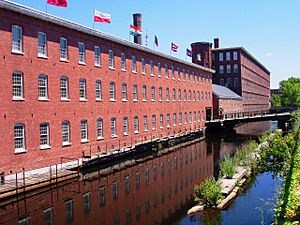
Massachusetts became a leader in industrial new ideas and growth during the 1800s. Since colonial times, there had been a successful iron-making industry in New England. The first successful ironworks in America was at Saugus in 1646. It used bog iron from swamps to make plows, nails, firearms, and other needed items. Other industries started during this time, like shipbuilding, lumber, paper, and furniture making. These small shops and factories often used the state's many rivers and streams to power their machines.
Samuel Slater had started the first successful textile mill in Pawtucket, Rhode Island in 1793. But there was still no efficient way to mass-produce cloth from the spun yarn. The yarn was sent to small weaving shops where it was woven on hand looms. The first woolen mill, and the second textile mill in the Blackstone Valley, was a "wool carding mill." Daniel Day started it in 1810 near the West River and Blackstone River at Uxbridge, Massachusetts.
Then, in 1813, a group of rich Boston merchants led by Francis Cabot Lowell started the first successful integrated textile mill in North America at Waltham. This group was known as the Boston Associates. Lowell had visited England in 1810 and studied their textile industry. The British government did not allow this new technology to be exported. So, Lowell memorized the plans for the power looms on his trip back to Boston. With the help of master mechanic Paul Moody, the first successful power looms were made. They used the power of the Charles River. For the first time, all steps of textile production could happen under one roof. This greatly increased production and profits. This was the true start of the Industrial Revolution in America.
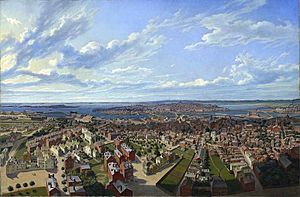
After the early success of the Boston Manufacturing Company at Waltham, the Boston Associates started several other textile towns. These included Lowell in 1823, Lawrence in 1845, Chicopee in 1848, and Holyoke in 1850.
Lowell quickly grew to a city of 33,000 people by 1850. Its mills were well-organized and controlled from one place. An clever canal system provided the water power for the machines. Steam power was introduced starting in the 1850s. The mill owners first hired local farm women, often from poor, remote parts of New England. They tried to create a perfect industrial society. They provided housing, churches, schools, and parks for their workers, unlike English factories. Eventually, as the mills grew, the owners hired newly arrived Irish immigrants to work in their factories.
Industrial cities, especially Worcester and Springfield, became important centers. Worcester focused on textile machinery. Springfield focused on precision tool production and new ideas. While Boston did not have many large factories, it became more important as the business and transportation center for all of New England. It was also a national leader in finance, law, medicine, education, arts, and publishing.
Railroads
In 1826, the Granite Railway became the first commercial railroad in the nation. In 1830, the state government approved three new railroads: the Boston and Lowell, the Boston and Providence, and the most important, the Boston and Worcester. In 1833, it approved the Western Railroad. This connected Worcester with Albany and the Erie Canal. The system grew well. Grain from the west started flowing to the port of Boston for export to Europe. This broke New York City's control over trade from the Erie Canal system.
Much of the construction work was done by Irish Catholic work gangs. They lived in temporary camps. Many settled in the new industrial cities along the line. The gang bosses became leaders in the Democratic Party. Some of their work is still used today. For example, the stone Canton Viaduct at Canton, Massachusetts, built in 1835, is still used by Amtrak's high-speed Acela Express. The viaduct needed only small changes to meet modern standards.
Whaling
Starting in the late colonial period, Massachusetts used its strong seafaring tradition. It had advanced shipbuilding and access to the oceans. This made the U.S. the top whaling nation by the 1830s. Whale oil was mainly needed for lamps. By the 1750s, whaling in Nantucket became a very profitable deep-sea industry. Voyages lasted for years, and ships traveled as far as the South Pacific.
The British Navy captured most whalers during the Revolution. But many whalers became privateers, attacking British ships. Whaling recovered after the war, with New Bedford becoming the center. Whalers took bigger risks for major profits. They expanded their hunting grounds and hired workers from other countries and within the U.S. After 1860, kerosene replaced whale oil. Also, Confederate ships destroyed many whaling vessels. So, business owners shifted to manufacturing.
Political and Social Movements
On March 15, 1820, Maine separated from Massachusetts. It became the 23rd state in the Union. This happened because of the Missouri Compromise.
Horace Mann made Massachusetts's school system a national example. The Commonwealth became important in Washington with leaders like Daniel Webster and Charles Sumner. Building on many active Congregational churches, abolitionism grew strong. William Lloyd Garrison was a leading voice. However, many "cotton Whig" mill owners complained. They said the anti-slavery movement hurt their strong business ties to southern cotton planters.
Congregationalists remained strong in rural areas. But in cities, a new religious feeling replaced their strict Calvinism. By 1826, Harriet Beecher Stowe reported:
All the literary men of Massachusetts were Unitarians. All the trustees and professors of Harvard College were Unitarians. All the élite of wealth and fashion crowded Unitarian churches. The judges on the bench were Unitarian, giving decisions by which the peculiar features of church organization, so carefully ordained by the Pilgrim fathers, had been nullified.
Some of the most important writers and thinkers of this time came from Massachusetts. Henry David Thoreau and Ralph Waldo Emerson are famous today for their ideas. They were part of a movement called Transcendentalism. They stressed the importance of nature and were also part of the abolitionist movement.
Know Nothing Movement
The Know Nothing movement formed a new political party in 1854. This party won almost all seats in the state legislature, the state government, and many cities. Historian John Mulkern says the new party was for the common people. It was against wealth, elites, and experts. It was also very suspicious of outsiders, especially Catholics.
The new party's voters were mainly in fast-growing industrial towns. There, Yankee workers competed directly with new Irish immigrants. The Whig party was strongest in rich areas. But the Know Nothing voters were strongest in poor areas. They voted out the traditional upper-class political leaders, especially lawyers and merchants. Instead, they elected working-class men, farmers, and many teachers and ministers. These new leaders rarely owned much property.
Nationally, Massachusetts passed the most aggressive and innovative laws. This included laws about nativism (being against immigrants) and reforms. Historian Stephen Taylor says that besides nativist laws:
- the party also distinguished itself by its opposition to slavery, support for an expansion of the rights of women, regulation of industry, and support of measures designed to improve the status of working people.
It passed laws to control railroads, insurance companies, and public services. It paid for free textbooks for public schools. It also increased money for local libraries and the school for the blind. Making Massachusetts pure from social problems was a high priority. The legislature set up the state's first reform school for young offenders. It also tried to block the import of supposedly dangerous government documents and academic books from Europe. It improved the legal rights of wives, giving them more property rights and divorce rights. It passed strict penalties on illegal bars and gambling houses. Many of these reforms were expensive. State spending rose 45% on top of a 50% increase in yearly taxes on cities and towns. This high spending angered taxpayers. Few Know Nothings were reelected, so this short two-year experiment ended.
A top priority was attacking the civil rights of Irish Catholic immigrants. State courts lost the power to handle citizenship applications. Public schools had to require daily reading of the Protestant Bible. The nativists were sure this would change Catholic children. The governor disbanded the Irish militias. He replaced Catholics in state jobs with Protestants. The party failed to get the two-thirds vote needed to change the state constitution. This change would have limited voting and office holding to men who had lived in Massachusetts for at least 21 years. The legislature then asked Congress to raise the requirement for becoming a citizen from five years to 21 years. But Congress never acted.
Civil War and Gilded Age: 1860–1900
In the years before the Civil War, Massachusetts was a center for social progress, Transcendentalism, and abolitionist activity. Horace Mann made the state's school system a national model. Two famous abolitionists from Massachusetts were William Lloyd Garrison and Wendell Phillips. Garrison started the New England Anti-Slavery Society in 1832. He helped change how people viewed slavery. The movement increased tension over slavery. This led to anti-abolitionist riots in Massachusetts between 1835 and 1837. The work of abolitionists helped lead to Massachusetts's actions during the Civil War.
Henry David Thoreau and Ralph Waldo Emerson made big contributions to American thought. They were part of the Transcendentalism movement. They stressed the importance of nature and feelings to humanity. Although there was strong opposition to abolitionism early on in Massachusetts, it grew over the next few decades. Famous abolitionist John Brown moved to Springfield in 1846. There, Brown first became a strong anti-slavery supporter. In Springfield and Boston, Brown met people who influenced him (Frederick Douglass and Sojourner Truth in Springfield). He also met people who later funded his efforts (Simon Sanborn and Amos Adams Lawrence in Boston) in Bleeding Kansas and John Brown's raid on Harpers Ferry. In 1850, Brown started his first anti-slavery group, The League of the Gileadites, in Springfield. Its goal was to protect escaped slaves from the 1850 Fugitive Slave Act.
Massachusetts was a hotbed of abolitionism, especially the progressive cities of Boston and Springfield. It played a role in the state's actions during the Civil War. Massachusetts was among the first states to answer President Lincoln's call for troops. Massachusetts was the first state to recruit, train, and arm a Black regiment with White officers, the 54th Massachusetts Volunteer Infantry. The Robert Gould Shaw Memorial on Boston Common shows a sculpture of the 54th regiment. Much of the Union's weapons for the Civil War were made in Springfield, at the Springfield Armory.
After the Civil War, thousands of immigrants from Canada and Europe continued to settle in Massachusetts's major cities. They were attracted by jobs in the state's growing factories. The state also became a leader in education and new ideas during this time, especially in the Boston area.
Invention of Basketball and Volleyball
In 1891 and 1895, the sports of basketball and volleyball were invented in Western Massachusetts. Basketball was invented in Springfield, and volleyball in Holyoke. Both are now Olympic sports, popular worldwide. Today, Springfield is home to the international Basketball Hall of Fame. Holyoke is home to the international Volleyball Hall of Fame.
Industrial Advance
In the 1890s, Greater Springfield became the United States' first major center for car and motorcycle innovation. This was largely because of the Springfield Armory, which employed many skilled mechanical workers. The United States' first gasoline-powered car company, the Duryea Motor Wagon Company, was founded in Chicopee in 1893. The first American motorcycle company, the Indian Motorcycle Company, was founded in Springfield in 1901. Knox Automobile produced the world's first motorized fire engines in Springfield in 1906.
Although the basic rail system was in place by 1860, railways continued to make big improvements. They improved tracks, signals, bridges, and facilities. With steel, trains became heavier and locomotives more powerful. In the 1880s, the Boston & Albany Railroad invested a lot in its physical structures. This included building over 30 new passenger stations. Famous Boston architect H. H. Richardson did much of the design work.
Passenger transportation changed greatly with the electric trolley. Thomas Davenport showed that electric railways could work in Springfield in the late 1870s. In 1889, the city's first line was built. By 1905, Springfield had more track than New York City. The lines provided fast, cheap transportation for farm products and workers. They created land booms in the suburbs and allowed for Sunday trips to the countryside. They were very profitable and made many people rich.
Prosperity Decades: 1900–1929
Massachusetts started the 20th century with a strong industrial economy. Even without much agricultural growth, the economy did well between 1900 and 1919. Factories across the Commonwealth made goods from paper to metals. In 1900, Boston was still the second most important port in the United States. It also had the most valuable fish market in the U.S. By 1908, however, the port's value dropped a lot due to competition. Population growth during this time, helped by immigration, led to more cities and changed the ethnic makeup of the Commonwealth.
However, Massachusetts's industrial economy began to weaken. This was because factory towns relied on making only one or two types of goods. Competition from lower-wage areas, along with other factors of the Great Depression later, caused the state's two main industries, shoes and textiles, to collapse. Between 1921 and 1949, the failure of these industries led to high unemployment. Once-rich industrial centers suffered urban decay for several decades.
The industrial economy started to decline in the early 1900s as many manufacturing companies left. By the 1920s, competition from the South and Midwest, followed by the Great Depression, caused the collapse of Massachusetts's three main industries: textiles, shoemaking, and mechanized transportation. This decline continued into the second half of the century. Between 1950 and 1979, the number of people in Massachusetts working in textile manufacturing dropped from 264,000 to 63,000. The Springfield Armory, which had made weapons for the U.S. Military since 1777, was controversially shut down by the Pentagon in 1968. This caused many high-paying jobs to leave Western Massachusetts, which suffered greatly as its industries declined during the last 40 years of the 1900s.
In Eastern Massachusetts, after World War II, the economy changed. It moved from heavy industry to services and high-tech. Government contracts, private investments, and research facilities led to a new and better industrial environment. This meant lower unemployment and higher income per person. Suburbs grew, and by the 1970s, the Route 128 area was filled with high-technology companies. These companies hired graduates from the many top universities in the area.
On Thursday, October 1, 1903, Boston made history. It hosted the first-ever World Series at the Huntington Avenue Grounds. The Boston Red Sox won the series and started a baseball dynasty in the following years. They won five championships in fifteen years, led by Hall of Famer Babe Ruth.
Depression and War: 1929–1945
Even before the Great Depression hit the United States, Massachusetts had economic problems. The collapse of the Commonwealth's major industries led to fewer people living in factory towns. The Boston area became one of the slowest-growing areas in the United States between 1920 and 1950. However, people moved within the Commonwealth during the Great Depression. They moved to the Boston area looking for jobs. But they found high unemployment and bad conditions. In Boston during this time, racial tension sometimes led to gang fights, especially between Irish and Italian groups.
Massachusetts also faced class conflict during this period. In the 1912 general strike in Lawrence, almost all the town's mills had to shut down. This was due to arguments over very low wages. The Commonwealth faced issues of worker conditions and wages. For example, when the legislature said women and children could only work 50 hours per week, employers cut wages proportionally. Eventually, the demands of the Lawrence strikers were met, and pay increased.
The economic and social problems in Massachusetts marked the start of a change in how the Commonwealth worked. Politics helped bring stability among social groups. It gave influential positions to people from different social classes and ethnic groups. Massachusetts's two main industries, shoes and textiles, had declined so much that even the economic boom after World War II could not reverse it. So, the Commonwealth's economy was ready for change as the post-war years began.
Economic Changes: Decline of Manufacturing 1945–1985
World War II brought big changes to Massachusetts's economy, which then changed society. After WWII, a global economy formed. It focused on the United States' interests, both military and business. The U.S. economy changed because of government spending on defense. In the years after WWII, Massachusetts changed from a factory-based economy to one based on services and technology. During WWII, the U.S. government built facilities. After the war, they leased and then sold these to defense companies. These facilities helped create an economy focused on making specialized defense goods. This type of economy grew because of the Cold War, the Vietnam War, and the Korean War.
In the following years, government contracts, private investments, and research facilities helped create modern industries. This reduced unemployment and increased income per person. All these economic changes encouraged suburban growth. They also led to a new generation of well-educated middle-class workers. At the same time, suburban growth and urban decay highlighted differences between social groups. This led to renewed racial tension. Boston, a good example of problems in Massachusetts cities, faced many challenges that led to racial issues. Problems in cities included fewer people, middle-class families moving out, industries leaving, high unemployment, rising taxes, low property values, and competition among ethnic groups.
The Kennedy Family
The Kennedy family was very important in Massachusetts politics in the 1900s. Children of businessman and ambassador Joseph P. Kennedy Sr. included John F. Kennedy. He was a senator and U.S. president before he was assassinated in 1963. Robert F. Kennedy was a senator, U.S. attorney general, and presidential candidate before he was assassinated in 1968. Ted Kennedy was a senator from 1962 until his death in 2009. Eunice Kennedy Shriver was a co-founder of the Special Olympics. The famous Kennedy Compound is located at Hyannisport on Cape Cod.
Modern Economy and Society: 1985–Present
Over the last 20–30 years, Massachusetts has become known as a center for education. This is especially true for higher education. It is also a hub for high-tech industries, including biotechnology and information technology. With generally good schools and many top universities, the area was well-suited to benefit from the technology-based economy of the 1990s. This recovery from manufacturing decline to a high-technology sector is often called the Massachusetts Miracle.
The Commonwealth had several notable citizens in the federal government in the 1980s. These included Senator Ted Kennedy, who almost ran for president, and House Speaker Tip O'Neill. Their influence in Congress helped Massachusetts get federal highway funding for the $14.6 billion Boston Central Artery/Tunnel Project. This project, known as "the Big Dig", was the most expensive federal highway project ever approved at the time. It was designed to help with Boston's traffic problems. It was approved in 1987 and mostly finished in 2005. The project was controversial because of huge budget overruns, repeated delays, water leaks in the new tunnels in 2004, and a ceiling collapse in 2006 that killed a person.
Several Massachusetts politicians have run for President of the United States during this period. They won the primary elections and then competed in the national elections. These include Michael Dukakis, who lost to George H. W. Bush in 1988. John Kerry lost to George W. Bush in 2004. Mitt Romney lost to Barack Obama in 2012.
On November 18, 2003, the Massachusetts Supreme Judicial Court (SJC) decided that the Commonwealth could not deny marriage rights to gay couples under the state constitution. On February 4, 2004, the SJC added that separate but equal civil unions, like those in Vermont, would not be constitutional. Only full gay marriage rights met constitutional guarantees. On May 17, 2004, the ruling took effect. Thousands of gay and lesbian couples across the Commonwealth got married.
Opponents of gay marriage then pushed for a change to the state constitution. This change would allow the state to deny marriage rights to gay couples. The amendment needed to be approved by at least 1/4 of the members present in two legislative sessions of the Massachusetts legislature. It also needed majority support in a public vote. It passed the first legislative session. But it was defeated in the second session, getting less than 1/4 of the votes from legislators. Public opinion polls show that most people in Massachusetts support gay marriage. So, it is likely that this issue is settled in Massachusetts.
More white-collar jobs have led to suburban growth. But the effects of this growth have been lessened by rules on land use and zoning. There is also an emphasis on "smart growth." In recent years, Massachusetts has lost population. High housing costs have driven many people away. The Boston area has the third most expensive housing market in the country. Over the last few years, about 19,000 people have moved out of the Commonwealth each year.
In 2006, the Massachusetts legislature passed the first plan in the United States to provide all citizens with universal health insurance coverage. It uses various private insurance providers. Insurance for low-income people is paid for with tax money. Higher-income people who do not have health insurance must buy it. The health insurance market is publicly regulated. So, in Massachusetts, no one can be denied coverage because of existing health conditions. They also cannot be forced to pay very high rates. The new universal coverage law, Commonwealth Care, is being put into action.
The Big Dig
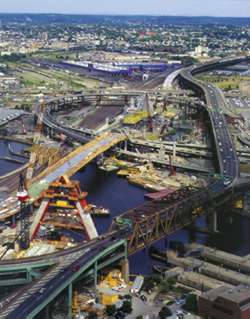
In 1987, the state received federal money for the Central Artery/Tunnel Project. Known as "the Big Dig", it was the largest federal highway project ever approved at the time. The project involved making the Central Artery a tunnel under downtown Boston. It also rerouted several other major highways. The project was often controversial. There were many claims of corruption and poor management. Its initial cost of $2.5 billion grew to over $15 billion. Despite this, the Big Dig has changed Downtown Boston. It has connected areas that were once divided by an elevated highway. Much of the old raised Central Artery was replaced with the Rose Kennedy Greenway. It also improved traffic conditions on several routes.
Boundaries
The history of Massachusetts's borders is quite complex. It spans several centuries. Land given to early colonists, mergers, separations, and solving border disputes all greatly shaped the state's modern shape. Arguments arose from overlapping land grants and inaccurate surveys. Having loyal settlers on the land also partly decided which parts of their large claims early groups kept.
Founding Grants
In 1607, the Plymouth Company was given a coastal charter. This covered all coastal land up to a certain distance from the eastern shoreline of North America, from 38°N to 45°N. The northern border was slightly north of today's Maine-New Brunswick border. The southern border intentionally overlapped with the Virginia Company of London from 38°N (near today's Maryland-Virginia border) to 41°N (near today's Connecticut-New York border in Long Island Sound). Neither colony could settle within 100 miles of the other. The Plymouth Company's patent was not used after the Popham Colony in Maine failed. Meanwhile, the Plymouth Colony settled outside the London Company's territory due to navigation problems. The Plymouth Company was reorganized as the Plymouth Council for New England. It was given a new royal sea-to-sea charter. This covered all North American land from 40° North (just east of today's Philadelphia and Trenton, New Jersey) and 48° N (including all of modern-day New Brunswick, Nova Scotia, and Prince Edward Island). The Plymouth Colony received land patents between 1621 and 1630 from the Council to make its settlement legal. However, it kept its political independence under the Mayflower Compact.
The Plymouth Council for New England made smaller land grants to various groups. Then, it was given back to the king in 1635 and stopped working as a company.
The Sheffield Patent gave the use of Cape Ann to members of the Plymouth Colony and the Dorchester Company. The fishing colony there failed, but it led to the founding of Salem, Massachusetts. The bankrupt Dorchester Company's lands were reissued as part of a larger grant to the Massachusetts Bay Company. Massachusetts Bay got a sea-to-sea patent in 1628/29. This covered all lands and islands from three miles north of the Merrimack River (roughly today's Massachusetts-New Hampshire border). It also covered land up to three miles south of the Charles River and Massachusetts Bay. The Charles River starts near Boston but flows in a winding path southeast to near today's Bellingham, Massachusetts, which is on the modern Rhode Island border. Land belonging to any other colonies as of November 3, 1629, was not included in the grant.
The border between the Massachusetts Bay Colony and Plymouth Colony was settled in 1639. Today, it forms most of the border between Norfolk County, Plymouth County, and Bristol County.
In 1622, Sir Ferdinando Gorges got a patent for the Province of Maine. This covered lands north of the Massachusetts Bay border near the Merrimack River, up to the Kennebec River. This was soon split at the Piscataqua River. The southern part eventually became the Province of New Hampshire. The northern part came under Massachusetts Bay control in the 1640s. In 1664, James, Duke of York got a charter for land from the Kennebec to the St. Croix River. He joined it to his Province of New York. New Hampshire was joined with Massachusetts Bay from 1641–1679 and during the dominion period (1686–1692).
The 1629 charter of Massachusetts Bay was canceled by a high court in England on June 18, 1684.
The Province of Massachusetts Bay was formed in 1691–92 by the British monarchs William and Mary. It included the Massachusetts Bay Colony, the Plymouth Colony, the Province of Maine (including eastern lands that had been part of New York), and Nova Scotia (which included today's New Brunswick and Prince Edward Island). Dukes County, Massachusetts (Martha's Vineyard and the Elizabeth Islands) and Nantucket were also moved from the Province of New York. In 1696, Nova Scotia was given back to France (who called it Acadia). But the northern and eastern borders of Maine were not set until the 1840s.
New Hampshire Boundary
The Province of New Hampshire received its own royal charter in 1679. But the words defining its southern border with Massachusetts Bay were unclear. They mentioned the Merrimack River in an ambiguous way:
- all that parte of New England in America lying and extending from the greate River commonly called Monomack als Merrimack on the northpart and from three Miles Northward of the said River to the Atlantick or Western Sea or Ocean on the South part [Pacific Ocean]
This led to disagreement over the northern boundary of Massachusetts. Governors often ignored it because they ruled both Massachusetts and New Hampshire. Massachusetts claimed land west of the Merrimack, calculated from the river's source. Early officials claimed this was the outlet of Lake Winnipesaukee in modern-day Franklin, New Hampshire. But New Hampshire claimed its southern border was a line three miles north of the river's mouth. The parties asked King George II of England to settle the dispute. He ordered them to agree. Commissioners from both colonies met at Hampton, New Hampshire in 1737, but could not agree.
In 1740, the King settled the dispute in a surprising way. He declared "that the northern boundary of Massachusetts be a similar curve line pursuing the course of the Merrimack River at three miles distance on the north side thereof, beginning at the Atlantic Ocean and ending at a point due north of a place called Pautucket Falls [now Lowell, Massachusetts], and by a straight line drawn from thence west till it meets his Majesty's other governments." This ruling favored New Hampshire. It actually gave New Hampshire a strip of land 50 miles beyond what it claimed. Massachusetts refused to do a physical survey, so New Hampshire placed markers on its own.
Rhode Island Eastern Border
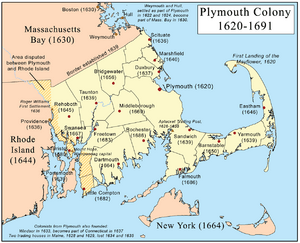
In 1641, the Plymouth Colony (separate from Massachusetts Bay at the time) bought a large area of land from Native Americans. This land now includes the northern half of East Providence, Rehoboth, Massachusetts, Seekonk, Massachusetts, and part of Pawtucket, Rhode Island. In 1645, John Brown of Plymouth bought a smaller piece of land from Native Americans. This land now includes the southern part of East Providence, Barrington, Rhode Island, and a small part of Swansea, Massachusetts. Finally, in 1661, Plymouth completed the "North Purchase." From this, Cumberland, Rhode Island, Attleboro, Massachusetts and North Attleborough, Massachusetts were later formed. All this land, which also included parts of modern Somerset, Massachusetts, and Warren, Bristol, and Woonsocket in Rhode Island, was called "Rehoboth" at the time. The center of "Old Rehoboth" was within the borders of modern East Providence, Rhode Island.
By the 1650s, Massachusetts Bay, the Colony of Rhode Island, the Connecticut Colony, and two different land companies all claimed what is now Washington County, Rhode Island. This area was called Narragansett Country. Massachusetts Bay had conquered Block Island in 1636. This was in response to a trader's murder at the start of the Pequot War. Massachusetts families settled there in 1661. The Plymouth Colony's land grant said its western border was the Narragansett River. It is unclear if this meant the Pawcatuck River (on today's Connecticut-Rhode Island Border) or Narragansett Bay (much farther east, near today's Rhode Island-Massachusetts border).
In 1663, Rhode Island got a patent that extended its territory three miles east of Narragansett Bay in certain places. In 1664, a royal commission appointed by King Charles II of England denied Massachusetts's and Plymouth's claims to land west of Narragansett Bay. It gave control to the newly unified Colony of Rhode Island and Providence Plantations. However, Plymouth's claims to all lands east of Narragansett Bay were upheld. So, the border was set in practice.
The 1691 charter combined Massachusetts Bay with Plymouth Colony (including Rehoboth). It stated that the combined territory would extend as far south as "Our Collonyes of Rhode Island Connecticut and the Marragansett Countrey" (Narragansett Country).
In 1693, the monarchs William and Mary issued a patent. It extended Rhode Island's territory to three miles "east and northeast" of Narragansett Bay. This conflicted with Plymouth Colony's claims. This made the conflict area between Rhode Island and the Province of Massachusetts larger.
The issue was not addressed until 1740. Rhode Island appealed to King George II of England. Royal commissioners from both colonies were appointed in 1741. They decided in favor of Rhode Island. The King confirmed the settlement in 1746 after appeals from both colonies. The royally approved three-mile boundary moved several towns on the eastern shore of Narragansett Bay (east of the mouth of the Blackstone River) from Massachusetts to Rhode Island.
This included what is now Bristol County, Rhode Island (the towns of Barrington, Bristol, and Warren). It also included Tiverton, Little Compton, and Cumberland, Rhode Island (which was created from Attleborough, Massachusetts). East Freetown, which stayed on the Massachusetts side, was officially bought by Freetown, Massachusetts, from Tiverton in 1747.
Commissioners from Rhode Island surveyed the new boundary in 1746. They did this without consulting Massachusetts. It was based on six reference points. From each point, a distance was measured 3 miles inland. Massachusetts accepted this border until 1791. Then, its own surveyors found that the Rhode Island surveyors had "encroached" on Massachusetts territory by a few hundred feet in some places. Rhode Island disagreed. A particular concern was the border near Fall River, Massachusetts. This area would later be a densely populated area with high taxable value.
In 1812, after a court case about the Massachusetts border, the western half of Old Rehoboth was made a separate town called Seekonk, Massachusetts. The eastern part remained Rehoboth, Massachusetts. Old Rehoboth's town center became the heart of Old Seekonk.
In 1832, Rhode Island filed a case with the U.S. Supreme Court. But after six years, it was dismissed. The court decided it did not have the power to rule on the matter.
In 1844 and 1845, commissioners were again allowed to survey and mark the boundary from Wrentham to the Atlantic Ocean. This was to fix the inaccuracies of the 1746 survey. A report was issued in 1848. But the Massachusetts legislature refused to agree to the proposed solution. This was after residents of Fall River asked them not to.
Both states filed bills of equity with the Supreme Court in 1852. After more surveying and talks, a decision was made on December 16, 1861. On March 1, 1862, when the Supreme Court ruling took effect, the western part of Old Seekonk was given by Massachusetts. It became East Providence, Rhode Island. Part of North Providence, Rhode Island was also combined with the former Pawtucket, Massachusetts, and a small piece of Seekonk. This formed the modern Pawtucket, Rhode Island. A small amount of land was also added to Westport, Massachusetts. The southern border of Fall River, Massachusetts was moved from Columbia Street to State Avenue, expanding its territory. The Supreme Court made these changes not by King George's instructions. Instead, it was to unite the densely settled areas of Pawtucket and Fall River under one state.
The 1861-62 boundary was slightly redefined in 1897. It used stone markers instead of high-water levels. The physical survey was done in 1898 and approved by both states.
Rhode Island Northern Border
In 1710–11, commissioners from Rhode Island and Massachusetts Bay agreed. A stake planted in 1642 by Nathaniel Woodward and Solomon Saffrey at Burnt Swamp Corner in Wrentham, Massachusetts, was the starting point for the border. This stake was said to be at 41°55′N. It was thought to be three miles south of the southernmost part of the Charles River.
The line extending west from the stake was surveyed in 1719, but it was inaccurate.
In 1748, Rhode Island appointed a commission to survey the line from the stake to the Connecticut border. But Massachusetts did not send a group. The surveyors could not find the 1642 stake. So, they marked a line from three miles south, by their calculation, of "Poppatolish Pond" (likely Populatic Pond, near Norfolk Airpark in Norfolk, Massachusetts). It was found that the Woodward and Saffrey stake was much farther south than three miles from the Charles River.
Rhode Island claimed its commissioners made a mistake by basing the border on the 1642 stake. In 1832, it filed a case with the Supreme Court of the United States. In 1846, the Court ruled in favor of Massachusetts. The same surveyors who marked the eastern boundary the previous year then marked the northern boundary. They filed their report in 1848. Rhode Island accepted the markings as the legal boundary if Massachusetts did the same. But Massachusetts did not do so until 1865. By that time, Rhode Island claimed that the 1861 Supreme Court case had changed things too much. This made the "line of 1848" unacceptable.
Connecticut Border
The town of Springfield was settled in 1636 by William Pynchon. It was called Agawam Plantation. It included today's towns of Westfield, Southwick, West Springfield, Agawam, Chicopee, Holyoke, Wilbraham, Ludlow, and Longmeadow in Massachusetts. It also included Enfield, Suffield, Somers, and East Windsor in Connecticut. It was connected to the Atlantic and major trade routes by the Connecticut River. This river ran past Hartford and through the Connecticut Colony.
At first, Springfield's founders attended Connecticut Colony meetings in Hartford. However, relations quickly worsened between the strong-minded leaders: William Pynchon of Springfield and Puritan Reverend Thomas Hooker of Hartford. Pynchon was a very clever businessman. His settlement quickly became more successful than the Connecticut towns in trading with Native Americans. In 1640, during a grain shortage, Hooker and other Connecticut leaders allowed Pynchon to buy grain for them. However, Native Americans refused to sell at fair prices, so Pynchon refused their offers. Hartford was furious with Pynchon's perceived greed. But Pynchon explained he was just trying to keep market prices stable so colonists would not pay too much later.
Furious, Hartford sent Captain John Mason to Pynchon's settlement "with money in one hand and a sword in the other." Mason threatened the Native Americans near Springfield with war if they did not sell grain at his demanded prices. Pynchon was disgusted by this. He had a friendly relationship with the Native Americans, and Mason's threats made him look bad. Mason believed Native Americans were untrustworthy. He exchanged some "hard words" with Pynchon before leaving Springfield. After Mason left, settlers of Agawam Plantation supported Pynchon. In 1640, they voted to join their settlement with the faraway government in Boston, rather than the nearby government in Hartford. Springfield had been settled with permission from the Massachusetts General Court, so Massachusetts assumed it had power over Pynchon's settlement anyway. They renamed it Springfield in Pynchon's honor.
In 1641, Connecticut started a trading post at Woronoke. This was in what was clearly Massachusetts territory (now Westfield). Massachusetts complained. Connecticut demanded that Springfield pay taxes to support the fort at the mouth of the river, in the Saybrook Colony. Springfield's leader, William Pynchon, would have agreed to the tax if Springfield could have a say at the Saybrook fort. However, Connecticut refused Springfield's request for representation. Pynchon appealed to Boston. Boston responded by threatening to charge Connecticut traders for using the port of Boston, which they relied on almost completely.
To show its power on the northern Connecticut River, the Massachusetts Bay Colony sent Nathaniel Woodward and Solomon Saffrey to survey and mark the border. They accidentally marked the border with Rhode Island much farther south than the king's rule of three miles south of the Charles River. Instead of traveling by land through Massachusetts, they sailed around and up the Connecticut River. They calculated the same latitude where they had misplaced the stake on the Rhode Island border. This made the error even worse. It resulted in a four to seven mile difference between where the border should have been and where it was marked. This gave Massachusetts Bay more land than its charter allowed. Although Connecticut was suspicious of this survey, it did not even receive a charter until 1662. So, the dispute remained quiet for several decades.
The towns of Woodstock, Suffield, Enfield, and Somers were started by Massachusetts. They were mainly settled by people from the Massachusetts Bay and Plymouth Colonies. In 1686, Suffield and Enfield (in Massachusetts) argued over town land with Windsor and Simsbury (in Connecticut). Massachusetts did not agree to a new survey. So, Connecticut hired John Butler and William Whitney to do the job. They found the southernmost part of the Charles River. Then they traveled west by land. Their 1695 report found that the 1642 line had been drawn too far south.
Confusion followed. Appeals to England were made in 1702 but failed. In 1713, a joint commission gave control of Springfield-area towns to Massachusetts. This was done without asking the residents of those towns. Connecticut was compensated with an equal amount of land further north. But the people in the Connecticut River border towns asked to be part of Connecticut in 1724. This might have been because of high taxes in Massachusetts or more freedoms in the Connecticut charter.
In 1747, Woodstock asked the General Assembly of Connecticut to join the colony. They argued that the land transfer from Massachusetts in 1713 had not been approved by The Crown. Suffield and Enfield soon followed. The legislature accepted them in May 1749. It declared the 1713 agreement invalid. Massachusetts continued to claim control in practice.
In 1770, Southwick, Massachusetts became independent from Westfield, Massachusetts. In May 1774, residents in southern Southwick also asked Connecticut to join and separate from northern Southwick. They argued they were south of the royally approved border of the Massachusetts Bay Colony (three miles south of the Charles River). The part west of Congamond Lake joined Simsbury. The part east of the lake joined Suffield.
In 1791 and 1793, commissioners from both states were sent to survey the border again. But they could not agree until a compromise was reached in 1803–04. Massachusetts accepted that the 1713 agreement was invalid and that it lost the border towns. But it regained the part of southern Southwick west of the lake. This resulted in today's border with Connecticut. It is a mostly straight east-west line, except for the "Southwick jog." This is a small, mostly rectangular piece of Massachusetts surrounded by Connecticut on three sides.
New York Border
Massachusetts claimed all land to the Pacific Ocean, based on its 1629 charter. But the Province of New York claimed the west bank of the Connecticut River (passing through Springfield, Massachusetts) as its eastern border. This was based on grants to the Duke of York in 1664 and 1674.
In 1773, the western border of Massachusetts was settled with New York in its current location. It was surveyed in 1787, following the line of magnetic north at the time. The starting point was a 1731 marker at the Connecticut–New York border. This was 20 miles inland from the Hudson River.
Massachusetts gave up control over its western lands (east of the Great Lakes) to New York in the Treaty of Hartford in 1786. But it kept the economic right to buy the Boston Ten Townships from Native Americans before anyone else. These purchase rights were sold to private individuals in 1788. The Commonwealth also gave up its claim to far western lands (Michigan and all other land to the Pacific Ocean) to Congress in 1785.
In 1853, a small triangle of land in the southwest corner of the Commonwealth, known as Boston Corners, was given from Mount Washington, Massachusetts to Ancram, New York. The mountainous land made it hard for Massachusetts authorities to enforce laws there. This made the area a safe place for outlaws and prize-fighters. Local residents asked for the transfer so New York authorities could clean up the hamlet.
Maine
From 1658 to 1820, Maine was a part of Massachusetts. In 1820, Maine separated from Massachusetts (with its permission). It was admitted into the Union as an independent state, as part of the Missouri Compromise.
Images for kids


